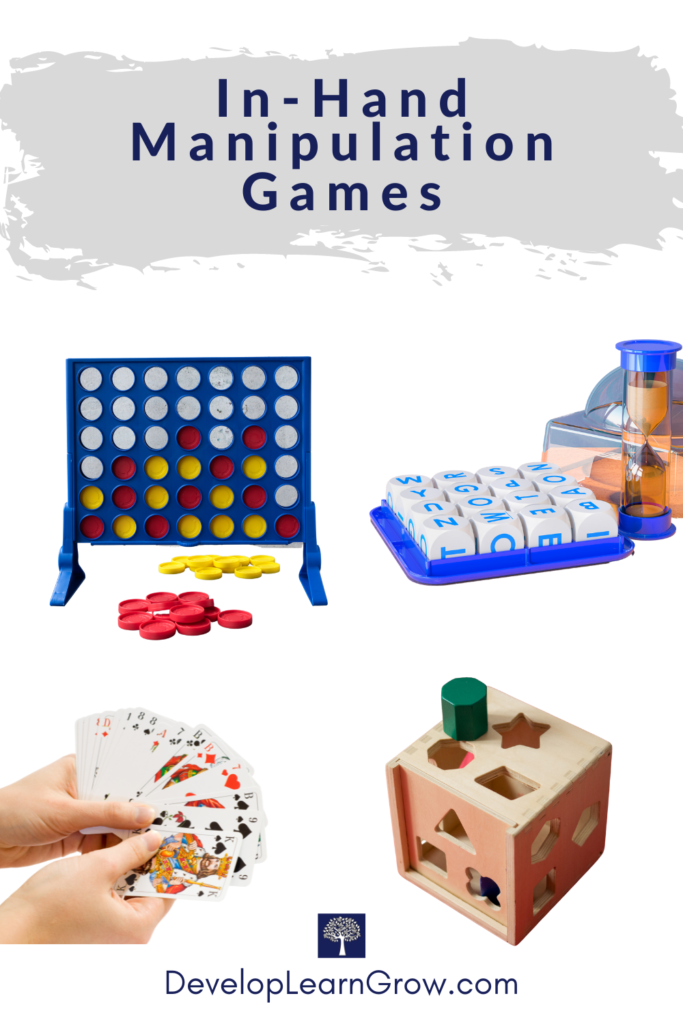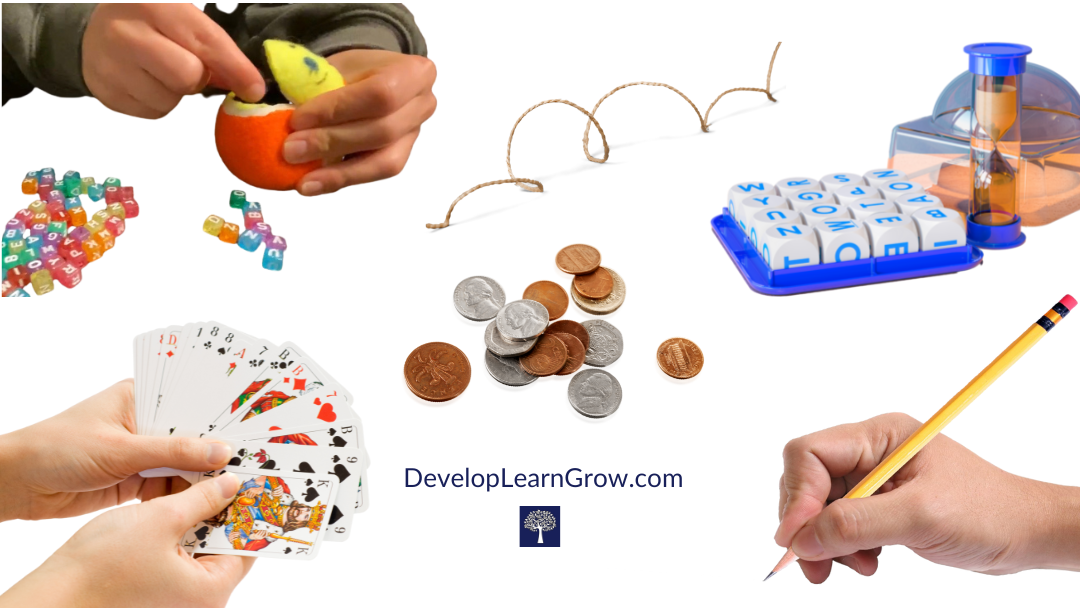Children need dexterity in the hands (in-hand manipulation skills) for success with daily fine motor activities. These hand skills help improve handwriting control (to use the lines and size letters correctly.)
Our hands are complex and unique! We have opposable thumbs for grasping and handling objects. And we have many bones and small muscles that allow for a variety of finger movements.
Coordinated and skilled finger movements are referred to as dexterity in the hands. In order to successfully move objects within our hands without dropping them, we need dexterity. We need skilled and coordinated movements.
In my occupational therapy world, dexterity in the hands is also called in-hand manipulation skills.
Dexterity in the Hands – What are In-Hand Manipulation Skills and Why Are They Important?
In-hand manipulation is the ability to move objects within the palm and fingertips with good control. This means without using the other hand to help, without dropping the items, AND/OR without using another surface or object to help.
I see many kids try to use their chest, a table surface, gravity, or even their chin to help control small objects within their hands! They lack dexterity within the hands and need to find help in some way to control the small items.
As an adult, you use these skills to adjust or reposition a debit card within your fingertips, to rotate keys to start an engine, or to unlock a door with a key. You also may use them when putting on delicate jewelry. Or, when taking apart or assembling an exercise machine with many screws, nuts and bolts. (I had to do this recently… not fun!)
In kids, dexterity and in-hand manipulation skills are used with many daily living activities at school and at home. For example, picking up small math manipulatives, adjusting papers to fit into a folder, or moving paper during cutting.
These fine motor skills are used when kids manage clothing fasteners (small buttons, zippers, shoe laces, belts) and when using utensils. Dexterity is also needed for small movements when coloring inside small areas. Or filling in small bubbles on those state tests!
During writing is when I see a great impact. A child needs to shift and adjust a pencil during writing. And, they need dexterity within the hands in order move the fingers to write small, age-appropriate sized letters that sit on the writing lines.
If kids don’t have good dexterity within the hands, they can have difficulty with daily tasks at home and at school.

What Types of In-Hand Manipulation Skills do Kids Need for Good Dexterity in The Hands?
In order to use our hands efficiently, we need core stability and shoulder stability.
[Check out 40 Core Strength Exercises for Kids – free printable and/or Vertical Surface and Floor Activities to Improve Core Stability – free printable]
Core and shoulder stability leads to forearm and wrist movements. Forearm and wrist stability supports finger movements.
Dexterity in the fingers requires stability in the forearm, wrist and thumb. It also requires fine motor strength, skill finger development and control of the arches of the hands. This allows for a variety of movement patterns when manipulating small objects.
Thumb stability, thumb mobility, and skill finger development are needed in order for kids to have more success with in-hand manipulation. (These skills are explained in Development of Pencil Grasp / Activities to Help Promote a Functional Grasp.)
There are three types of in-hand manipulation skills that I look at as an occupational therapist:
- Translation (finger to palm and palm to finger) – moving an object in a straight line by bending and straightening the fingers
- Rotation (simple and complex) – turning an object with the fingertips or using the fingers to rotate an object end over end
- Shift – using the pads of the skill fingers to move along an object in a linear motion
When Do In-Hand Manipulation Skills Develop?
Babies and toddlers begin to use finger to palm translation between 12 and 15 months. They begin to use palm to finger translation and simple rotation between 2 years and 2 1/2 years. They continue to develop complex rotation and can have success by age 4.
Between 3 1/2 and 5 years, children develop rotation and shift (with shift starting to begin between 3 and 3 1/2 years.) In preschool (after age 3) kids start to use in-hand manipulation skills more consistently.
This fine motor development continues into kindergarten and first grade. Between ages 6-7, kids use a variety of in-hand manipulation skills during play, daily routines, and learning activities. These fine motor skills continue to develop up to age 10.
By age 12, kids are still refining their dexterity. Many students that I work with need practice with in-hand manipulation skills. I see students in kindergarten and first grade have difficulty with skills that should have developed when they were toddlers.
In-hand manipulation activities help my students decrease the size of their writing between 2nd and 3rd grade. Even 4th and 5th graders have needed help with finger dexterity. These fine motor activities also help with control when keeping letters on the line.
In-Hand Manipulation Activities That Improve Dexterity in the Hands (for Fine Motor Development and Improved Handwriting)
The three types of in-hand manipulation skills are translation, rotation, and shift. There are several activities that support each skill area.
Translation Activities
Translation is the ability to move objects in straight, linear patterns. The fingers bend and straighten to move an object.
There are two types: finger to palm translation and palm to finger translation. Each one is pretty much self-explanatory!
For example, kids use translation when picking up Cheerios one at a time with the fingertips and tucking them into the palm. Then, they use translation to move a Cheerio from the palm back to the fingertips and into the mouth!
This is done successfully without dropping the food or without using the other hand (or anything else) to help. And it’s done successfully without turning the hand over to allow gravity to help the object fall into the palm.
Activities that work on translation:
- Picking up small coins one at a time, keeping them in the palm, and then placing them one at a time into a slot in a piggy bank
- Sliding buttons or chips into a container with a slit in it
- Picking up small beads one at a time to place on a string
- Gathering 4-5 small pegs in the palm to place into a pegboard
- Crumbling paper scraps into a tight ball
- Feed a tennis ball (great to strengthen the hand as well! – see photo)
During translation, make sure your kiddos are using only one hand with the palm facing down as they pick up the small objects. Check to make sure they aren’t using anything else to help. If they drop objects frequently, decrease the amount that you ask them to pick up.
During palm to finger translation, I find it helpful to tell kids: “use your thumb to help slide one piece up to the tips of your fingers.” Show them, and encourage them to use the skills fingers (thumb, index and middle) or the thumb and index finger.
Rotation Activities
Rotation is the ability to turn an object in circular motions with the fingertips or within the hand. There are two types: simple rotation and complex rotation.
Simple rotation involves using the pads of the thumb, index and middle fingers to turn an object. For example, removing a small cap from a bottle or rotating a shape to fit into a shape sorter.
Complex rotation is turning an object end over end. An example of this would be flipping a pencil around to use the eraser.
Activities that work on simple rotation:
- Rolling small balls of playdoh with the fingertips
- Puzzles with small pieces such as mini perfection
- Spinning letter or design cubes around in the fingertips
- Activating wind-up toys
- Spinning tops
- Removing and replacing small lids
Activities that work on complex rotation:
- Spin a small baton with one hand
- Pencil cartwheels – keep the arm still, hold the pencil in the middle and turn it end over end to make it spin in a circle
- Spin a stick in clockwise, then counterclockwise directions
- Flip a stick or straw around and placing it into an opening
- Pick up large pegs, game or puzzle pieces and flip them over to put them in correctly
- Spin large marbles or metal balls around in the palm
Shift Activities
Shift is the ability to use the pads of the skill fingers to move along an object in a linear motion.
This skill is used when fanning playing cards and when separating pieces of paper. It’s a really helpful skill for kids during cutting. The helper hand holds and moves along the paper fore better control with the cutting hand.
During writing, this hand skill is used when adjusting the position of the pencil within the hands. Small adjustments are often needed after picking up a pencil or after flipping it around to erase.
Activities that work on shift:
- Play card games
- Lace paper clips onto string
- Hold a paper or cardboard clock, spin it in the fingers around the numbers
- Hold a pencil in the writing position, then walk the fingers up and down the pencil
- String large beads, straws, or sewing spools (with string or pipe cleaner)
- Use helper hand during cutting activities
During these types of hand dexterity activities, make sure that your kids are only using their fingers to move and control the objects. Some kids will use the table surface to give extra help. Or, they’ll use extra movements to allow gravity to help with coordination and control.

In-Hand Manipulation GAMES to Improve Dexterity in the Hand (My School-Based OT Favorites!)
There are several games and fine motor activities that I use (or adapt) to encourage dexterity in the hands. For example, if I have a student play connect-4, I’ll have them pick up 4-5 small chips at a time. Then, they have to put them in one at a time with one hand, without dropping any.
If we are ‘feeding a tennis ball’, I’ll have them pick up 3-4 letter beads at a time and place them into the ball one at a time. I lessen or increase the challenge as needed for each kiddo. I try to vary the sizes, textures and shapes of small items that I use.
Some games listed below involve combinations of in-hand manipulation skills. Many also address other fine motor skills that kids need when developing the hand muscles.
[Amazon affiliate links are used below with no additional cost for you. See below for more info]
Games that improve dexterity within the hands:
- Mini Spiral Glitter Wands
- Boggle Jr
- Mancala
- Perfection
- Mini Connect 4
- Counting Pegs
- Lite Brite
- Card Game Set
- Multi-Matrix (Therapeutic Block Game)
- Lowercase Lacing Letters
- Tennis Ball Animals (cut a small slit for a mouth, use small beads or buttons)
- Piggy Bank
- Fine Motor Hedgehog
- Wooden Shape Sorter
Related Posts:
Form Letters Properly with These 9 Helpful Tips
Correct Sitting Posture for Kids – An Important Tip!
Simple DIY Math Manipulatives for Tactile and Kinesthetic Learning
Development of Pencil Grasp – How to Promote a Functional Grasp with 5 Types of Activities
[As an Amazon Associate I earn from qualifying purchases. If you choose to click on an Amazon link and make a purchase, Develop Learn Grow may earn a small commission. If you do end up making a purchase after clicking one of my links, THANK YOU for your support to the time and money spent on this blog!]
Resources Used in this Post:
Case-Smith J, O’Brien JC. Occupational Therapy for Children. 6th ed. Missouri: Mosby Elsevier; 2010: 275-312.
Visser, Marieta, Nel, Mariette, du Plessis, Carla, Jacobs, Shame, Joubert, Amor, Muller, Martli, Smith, Bianco, van Heerden, Tania, & van Soest, Renette. (2016). In-hand manipulation (IHM) in children 6 and 7 years of age: A follow-up study. South African Journal of Occupational Therapy, 46(2), 52-58.



0 Comments